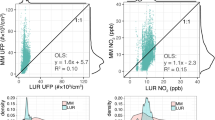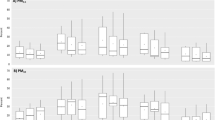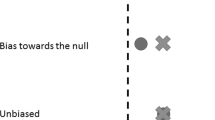Abstract
This project was motivated by the investigation of the impact of primary oil and gas infrastructure on levels of air pollutants in western Canada. In the published models, we assumed that the distances between sources and air monitors were the key determinants of exposure and were measured precisely. These models related the logarithm of air pollutant concentration to a function of separation distance (“distance weight”). We undertook a simulation study to determine the impact on the observed source-pollutant association of uncertainty in the separation distance and the number of relevant sources per monitoring station. We observed that both the number of sources in the vicinity of the monitoring station and the extent of error in the estimate of separation distance influence the estimate of the slope of the source-pollution association. Measurement error tended to attenuate the association and degrade power, whereas the greater number of sources per monitoring station also led to a shallower observed slope. Attempts to correct the estimates of the slope were hampered by the non-standard nature of the frequency distribution of the difference between distance weights based on true and mismeasured distances. Our results revealed unanticipated challenges in the interpretation and estimation of the original analyses.
This is a preview of subscription content, access via your institution
Access options
Subscribe to this journal
Receive 6 print issues and online access
$259.00 per year
only $43.17 per issue
Buy this article
- Purchase on Springer Link
- Instant access to full article PDF
Prices may be subject to local taxes which are calculated during checkout


Similar content being viewed by others
Notes
If we were able to write explicitly error model in Eq. (4), we would proceed straight to measurement error correction instead of trying to understand the properties of measurement error through simulations.
References
Burstyn I., Senthilselvan A., Kim H.-M., Pietroniro E., Waldner C.L., and Cherry N.M. Industrial sources influence air concentrations of hydrogen sulfide and sulfur dioxide in rural areas of western Canada. J Air Waste Manage Assoc 2007a: 57: 1241–1250.
Burstyn I., Teschke K., Kennedy S. Exposure levels and determinants of inhalable dust exposure in bakeries. The Annals of Occupational Hygiene 1997: 41: 609–624.
Burstyn I., You X.I., Cherry N.M., and Senthilselvan A. Determinants of airborne benzene concentrations in rural areas of western Canada. Atmos Environ 2007b: 41: 7778–7787.
Carroll R.J., Ruppert D., and Stefanski L.A. Measurment Error in Nonlinear Models. Chapman and Hall Ltd, London, England, 1995.
Cook J.D., and Stefanski L.A. Simulation-extrapolation estimation in parametric measurement error models. J Am Stat Assc 1994: 89: 1314–1328.
Gustafson P. Measurement Error and Misclassification in Statistics and Epidemiology. Chapman and Hall/CRC Press, 2003, New York.
R Development Core Team. R: A Language and Environment for Statistical Computing. ISBN 3-900051-07-0. R Foundation for Statistical Computing, Vienna, Austria, 2006.
Rosner B., Willett W.C., and Spiegelman D. Correction of logistic regression relative risk estimates and confidence intervals for systematic within-person measurement error. Stat Med 1989: 8: 1051–1069.
Scott H.M., Soskolne C.L., Martin S.W., Shoukri M.M., Lissemore K.D., Coppock R.W., and Guidotti T.L. Air emissions from sour-gas processing plants and dairy-cattle reproduction in Alberta, Canada. Prev Vet Med 2003a: 57: 69–95.
Scott H.M., Soskolne C.L., Wayne M.S., Ellehoj E.A., Coppock R.W., Guidotti T.L., and Lissemore K.D. Comparison of two atmospheric-dispersion models to assess farm-site exposure to sour-gas processing-plant emissions. Prev Vet Med 2003b: 57: 15–34.
Spiegelman D., Schneeweiss S., and McDermott A. Measurement error correction for logistic regression models with an “alloyed gold standard”. Am J Epidemiol 1997: 145: 184–196.
Strosher M.T. Investigations of Flare Gas Emissions in Alberta. Final Report to: Environment Canada Conservation and Protection, the Alberta Energy and Utilities Board and the Canadian Association of Petroleum Producers. Alberta Research Council, Calgary, AB, 1996.
WISSA. Western Canada Study of Animal Health Effects Associated with Exposure to Emissions from Oil and Natural Gas Field Facilities: Research Appendices. Calgary, Western Interprovincial Scientific Studies Association, AB, Canada, 2006.
You X.I., Senthilselvan A., Cherry N.M., Kim H.G., and Burstyn I. Determinants of airborne concentrations of volatile organic compounds in rural areas of Western Canada. J Expo Sci Environ Epidemiol 2008: 18: 117–128.
Acknowledgements
This research was supported by the National Sciences and Engineering Research Council Discovery Grant to Igor Burstyn. Dr. Igor Burstyn was supported by salary awards from the Canadian Institutes for Health Research and the Alberta Heritage Foundation for Medical Research. Dr. Nicola M. Cherry (University of Alberta) and Dr. Hyang-Mi Kim (University of Calgary) provided valuable comments on the draft of this article. Michele Hamm proofread and edited the final article.
Author information
Authors and Affiliations
Corresponding author
Rights and permissions
About this article
Cite this article
Burstyn, I. Impact of measurement error on quantifying the importance of proximity to point sources of air pollution. J Expo Sci Environ Epidemiol 20, 12–18 (2010). https://doi.org/10.1038/jes.2008.67
Received:
Accepted:
Published:
Issue Date:
DOI: https://doi.org/10.1038/jes.2008.67



